Effect of Zn and Cu Addition on Mechanical Properties of As-Extruded Mg-3Sn-1Ca Alloy
Abstract
:1. Introduction
2. Experimental Procedure
3. Results
Microstructure Characterization
4. Discussion
4.1. Microstructure Analysis
4.2. Texture Analysis
4.3. Mechanical Property Analysis
5. Conclusions
- In the TX31 alloy, except for a large amount of CaMgSn phase, the addition of Cu forms the spherical Mg2Cu phase, the addition of Zn is solidly dissolved in the magnesium matrix, and the combined addition of Zn and Cu can form MgZnCu phase.
- Due to the existence of a large number of CaMgSn phase and Mg2Cu hard brittle phase in the as-extruded TX31 and TXC311 alloys, the plasticity is poor, which can be improved by adding Zn.
- Among the four as-extruded alloys, the tensile strength and yield strength are TXCZ3111 > TXC311 > TXZ311 > TX31, and the EL is TXZ311 > TXCZ3111 > TXC311 > TX31. The TXCZ3111 alloy has the best comprehensive mechanical properties, with a UTS, YS and EL of 244 MPa, 159 MPa and 13.4%, respectively. The strength of the TXC311 alloy is equivalent to that of TXCZ3111 alloy, but the plasticity is much lower than that of the TXCZ3111 alloy. The TXZ311 alloy has the best plasticity, but its strength is slightly lower than the TXCZ3111 alloy.
Author Contributions
Funding
Institutional Review Board Statement
Informed Consent Statement
Data Availability Statement
Acknowledgments
Conflicts of Interest
References
- Prasad, S.V.S.; Prasad, S.B.; Verma, K.; Mishra, R.K.; Kumar, V.; Singh, S. The role and significance of Magnesium in modern day research-A review. J. Magnes. Alloy. 2022, 10, 1–61. [Google Scholar] [CrossRef]
- Lesz, S.; Hrapkowicz, B.; Karolus, M.; Gołombek, K. Characteristics of the Mg-Zn-Ca-Gd Alloy after Mechanical Alloying. Materials 2021, 14, 226. [Google Scholar] [CrossRef] [PubMed]
- Xiang, C.; Xiao, Z.; Ding, H.; Wang, Z. Compressive Properties and Energy Absorption Characteristics of Extruded Mg-Al-Ca-Mn Alloy at Various High Strain Rates. Materials 2020, 14, 87. [Google Scholar] [CrossRef] [PubMed]
- Jiang, P.; Carsten, B.; Bohlen, J.; Zheludkevich, M. Corrosion performance, corrosion fatigue behavior and mechanical integrity of an extruded Mg4Zn0.2Sn alloy. J. Mater. Sci. Technol. 2020, 59, 107–116. [Google Scholar] [CrossRef]
- Pan, H.; Qin, G.; Xu, M.; Fu, H.; Ren, Y.; Pan, F.; Gao, Z.; Zhao, C.; Yang, Q.; She, J.; et al. Enhancing mechanical properties of Mg–Sn alloys by combining addition of Ca and Zn. Mater. Des. 2015, 83, 736–744. [Google Scholar] [CrossRef]
- Kavyani, M.; Ebrahimi, G.R.; Ezatpour, H.R.; Jahazi, M. Microstructure refinement, mechanical and biocorrosion properties of Mg-Zn-Ca-Mn alloy improved by a new severe plastic deformation process. J. Magnes. Alloy. 2021, in press. [Google Scholar] [CrossRef]
- Chang, L.L.; Tang, H.; Guo, J. Strengthening effect of nano and micro-sized precipitates in the hot-extruded Mg-5Sn-3Zn alloys with Ca addition. J. Alloy. Compd. 2017, 703, 552–559. [Google Scholar] [CrossRef]
- Rao, K.P.; Prasad, Y.V.R.K.; Hort, N.; Kainer, K.U. Hot workability characteristics of cast and homogenized Mg-3Sn-1Ca alloy. J. Mater. Process. Technol. 2008, 201, 359–363. [Google Scholar] [CrossRef]
- Wang, C.; Zeng, L.; Zhang, W.; Tang, F.; Ding, W.; Xiao, S.; Liang, T. Enhanced mechanical properties and corrosion resistance of rolled Mg-1.5Sn-0.5Ca alloy by Ce microalloying. Mater. Charact. 2021, 179, 111325. [Google Scholar] [CrossRef]
- Kim, J.; Choi, J.; Kim, Y.; Yoo, H.; Woo, K.; Lee, S.; Son, H. Microstructures and Thermal Properties of Mg-Sn-Ca Alloys: Casts and Extrusions. Int. J. Thermophys. 2015, 36, 2666–2673. [Google Scholar] [CrossRef]
- Basu, M.; Chen, J.; Wheeler, R.E.; Schäublin, J.F. Löffler, Segregation-driven exceptional twin-boundary strengthening in lean Mg-Zn-Ca alloys. Acta Mater. 2022, 229, 117746. [Google Scholar] [CrossRef]
- Shi, G.; Yuan, J.; Li, T.; Zhang, K.; Li, X.; Li, Y.; Ma, M. Enhanced precipitation strengthening of extruded Mg-8wt.%Al-0.5 wt.%Zn (AZ80) magnesium alloy by extension twinning. Mater. Sci. Eng. A 2020, 774, 138906. [Google Scholar] [CrossRef]
- Wang, J.; Ferdowsi, M.R.G.; Kada, S.R.; Lynch, P.A.; Wang, Z.; Kimpton, J.A.; Barnett, M.R. Stress relaxations during cyclic loading-unloading in precipitation hardened Mg-4.5Zn. Acta Mater. 2021, 205, 116531. [Google Scholar] [CrossRef]
- Wang, H.; Rong, J.; Liu, G.; Zha, M.; Wang, C.; Luo, D.; Jiang, Q. Effects of Zn on the microstructure and tensile properties of as-extruded Mg-8Al-2Sn alloy. Mater. Sci. Eng. A 2017, 698, 249–255. [Google Scholar] [CrossRef]
- Ha, H.Y.; Kang, J.Y.; Yang, J.; Yim, C.; You, B. Limitations in the use of the potentiodynamic polarisation curves to investigate the effect of Zn on the corrosion behaviour of as-extruded Mg-Zn binary alloy. Corros. Sci. 2013, 75, 426–433. [Google Scholar] [CrossRef]
- Ha, H.Y.; Kang, J.Y.; Yim, C.D.; Yang, J. Role of hydrogen evolution rate in determining the corrosion rate of extruded Mg-5Sn-(1-4wt%)Zn alloys. Corros. Sci. 2014, 89, 275–285. [Google Scholar] [CrossRef]
- Pan, F.; Mao, J.; Zhang, G.; Tang, A.; She, J. Development of high-strength, low-cost wrought Mg−2.0mass%Zn alloy with high Mn content. Prog. Nat. Sci. Mater. Int. 2016, 26, 630–635. [Google Scholar] [CrossRef]
- Guo, K.; Xu, C.; Lin, X.; Ye, J.; Zhang, C.; Huang, D. Microstructure and strengthening mechanism of Mg-5.88Zn-0.53Cu-0.16Zr alloy solidified under high pressure. Trans. Nonferrous Met. Soc. China 2020, 30, 99–109. [Google Scholar] [CrossRef]
- Lotfpour, M.; Dehghanian, C.; Emamy, M.; Bahmani, A.; Malekan, M.; Saadati, A.; Taghizadeh, M.; Shokouhimehr, M. In-vitro corrosion behavior of the cast and extruded biodegradable Mg-Zn-Cu alloys in simulated body fluid (SBF). J. Magnes. Alloy. 2021, 9, 2078–2096. [Google Scholar] [CrossRef]
- Li, X.; Liu, J.; Luo, C. Precipitation behavior of cast ZC62 magnesium alloy. Acta Metall. Sin. 2006, 42, 733–738. [Google Scholar]
- Zhu, H.M.; Sha, G.; Liu, J.W.; Wu, C.L.; Luo, C.P.; Liu, Z.W.; Zheng, R.K.; Ringer, S.P. Microstructure and mechanical properties of Mg-6Zn-xCu-0.6Zr (wt.%) alloys. J. Alloy. Compd. 2011, 509, 3526–3531. [Google Scholar] [CrossRef]
- Tang, Y.; Chen, Y.; Xiao, S.; Ding, W.; Wang, C.; Liu, X. Microstructure, Mechanical Properties and Compressive Creep Behavior of as-Cast Mg-5Sn-(0∼2)Cu Alloys. Rare Met. Mater. Eng. 2014, 43, 1291–1295. [Google Scholar]
- Tang, W.N.; Park, S.S.; You, B.S. Effect of the Zn content on the microstructure and mechanical properties of indirect-extruded Mg-5Sn-xZn alloys. Mater. Des. 2011, 32, 3537–3543. [Google Scholar] [CrossRef]
- Wang, C.; Guo, S.; Zeng, L.; Zheng, D.; Xu, J.; Yang, M.; Liang, T. Effects of Second Phases on Microstructure, Microhardness, and Corrosion Behavior of Mg-3Sn-(1Ca) Alloys. Materials 2019, 12, 2515. [Google Scholar] [CrossRef] [PubMed] [Green Version]
- Wang, S.; Huang, Y.; Yang, L.; Zeng, Y.; Hu, Y.; Zhang, X.; Sun, Q.; Shi, S.; Meng, G.; Hort, N. Microstructure and mechanical properties of Mg-3Sn-1Ca reinforced with AlN nano-particles. J. Magnes. Alloy. 2021, in press. [Google Scholar] [CrossRef]
- SPark, H.; Jung, J.-G.; Kim, Y.M.; You, B.S. A new high-strength extruded Mg-8Al-4Sn-2Zn alloy. Mater. Lett. 2015, 139, 35–38. [Google Scholar]
- Luo, Y.; Chen, Y.; Ran, L.; Pang, X.; Pan, F. Effects of Zn/Al mass ratio on microstructure evolution and mechanical properties of Mg-Sn based alloys. Mater. Sci. Eng. A 2021, 815, 141307. [Google Scholar] [CrossRef]
- Ding, Z.; Zhang, S.; Zhao, Y.; Chen, D. Effect of Al addition on microstructure and mechanical properties of Mg−Gd−Zn alloys. Trans. Nonferrous Met. Soc. China 2022, 32, 824–837. [Google Scholar] [CrossRef]
- Blake, A.H.; Cáceres, C.H. Solid-solution hardening and softening in Mg–Zn alloys. Mater. Sci. Eng. A 2008, 483–484, 161–163. [Google Scholar] [CrossRef]
- Kim, H.L.; Park, J.S.; Chang, Y.W. Effects of lattice parameter changes on critical resolved shear stress and mechanical properties of magnesium binary single crystals. Mater. Sci. Eng. A 2012, 540, 198–206. [Google Scholar] [CrossRef]
- Hutchinson, W.B.; Barnett, M.R. Effective values of critical resolved shear stress for slip in polycrystalline magnesium and other hcp metals. Scr. Mater. 2010, 63, 737–740. [Google Scholar] [CrossRef]
- Ghori, U.R.; Prasad, A.; Lu, Y.; Chiu, Y.L.; Jones, I.P.; Singh, S.S.; Gosvami, N.N.; Jain, J. Outstanding enhancement in critical resolved shear stress of basal slip with precipitation in Mg-10Dy-0.7La alloy: A micro-pillar compression study. Mater. Lett. 2022, 308, 131265. [Google Scholar] [CrossRef]
- Liu, L.Z.; Pan, F.S.; Chen, X.H.; Huang, Y.D.; Song, B.; Yang, H.; Hort, N. The effect of Y addition on recrystallization and mechanical properties of Mg-6Zn-xY-0.5Ce-0.4Zr alloys. Vaccum 2018, 155, 445–455. [Google Scholar] [CrossRef]
- Du, Y.Z.; Qiao, X.G.; Zheng, M.Y.; Wua, K.; Xu, S.W. The microstructure, texture and mechanical properties of extruded Mg-5.3Zn-0.2Ca-0.5Ce (wt%) alloy. Mater. Sci. Eng. A 2015, 620, 164–171. [Google Scholar] [CrossRef]
- Starink, M.J.; Qiao, X.G.; Zhang, J.; Gao, N. Predicting grain refinement by cold severe plastic deformation in alloys using volume averaged dislocation generation. Acta Metall. 2009, 57, 5796–5811. [Google Scholar] [CrossRef] [Green Version]
- Nie, J.F. Effects of precipitate shape and orientation on dispersion strengthening in magnesium alloys. Scr. Mater. 2003, 48, 1009–1015. [Google Scholar] [CrossRef]
- Wang, Q.H.; Jiang, B.; Tang, A.T.; Ma, S.X.; Jiang, Z.T.; Chai, Y.F.; Liu, B.; Pan, F.S. Ameliorating the mechanical properties of magnesium alloy: Role of texture. Mater. Sci. Eng. A 2017, 689, 395–403. [Google Scholar] [CrossRef]
- Ma, C.; Guan, X.; Sun, L.; Liu, G. Microstructure and mechanical properties of modified Mg–8Al–2Sn alloys using Zn addition combined with artificial aging treatment. Mater. Sci. Eng. 2022, 831, 142278. [Google Scholar] [CrossRef]
- Son, H.T.; Lee, J.S.; Oh, I.H.; Kim, D.G.; Yoshimi, K.; Maruyama, K. Microstructure and mechanical properties of Mg–Al–Ca–Nd alloys fabricated by gravity casting and extrusion process. Mater. Trans. 2008, 49, 1025–1031. [Google Scholar] [CrossRef]
- Yan, X.; Wan, P.; Chen, L.; Tan, L.; Xu, X.; Yang, K. Microstructural effects on mechanical properties and degradation behavior of Mg–Cu alloy. Materialia 2021, 16, 101089. [Google Scholar] [CrossRef]
- Yin, S.; Zhang, Z.; Liu, X.; Le, Q.; Lan, Q.; Bao, L.; Cui, J. Effects of Zn/Gd ratio on the microstructures and mechanical properties of Mg-Zn-Gd-Zr alloys. Mater. Sci. Eng. A 2017, 695, 135–143. [Google Scholar] [CrossRef]
- Zhao, C.; Chen, X.; Pan, F.; Wang, J.; Gao, S.; Tu, T.; Liu, C.; Yao, J.; Atrens, A. Strain hardening of as-extruded Mg-xZn(x=1, 2, 3 and 4 wt%) alloys. J. Mater. Sci. Technol. 2019, 35, 142–150. [Google Scholar] [CrossRef] [Green Version]
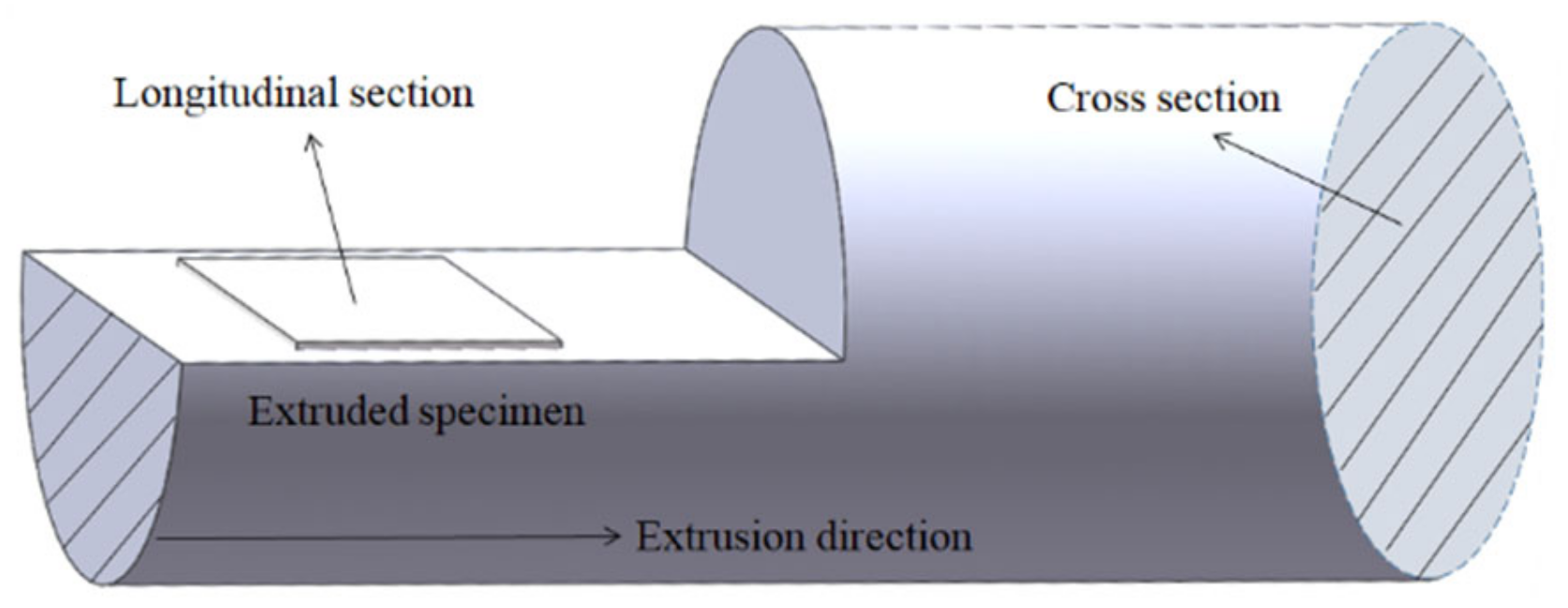
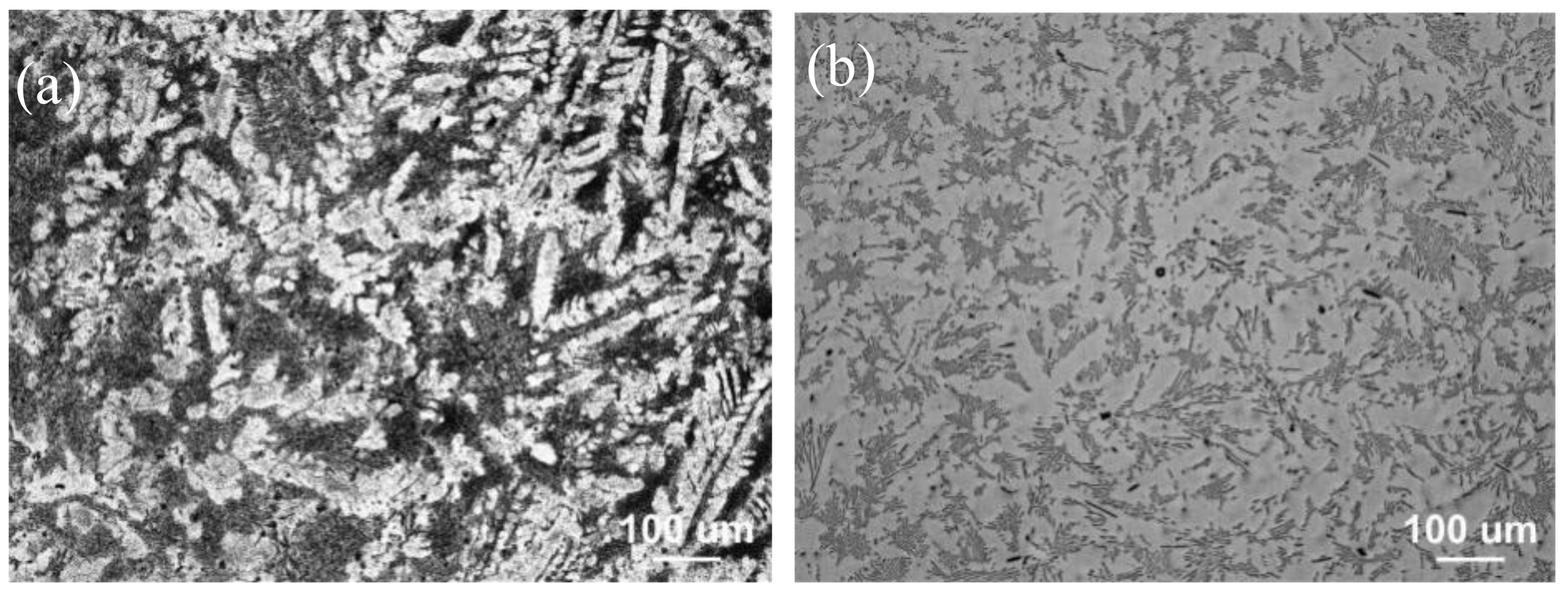
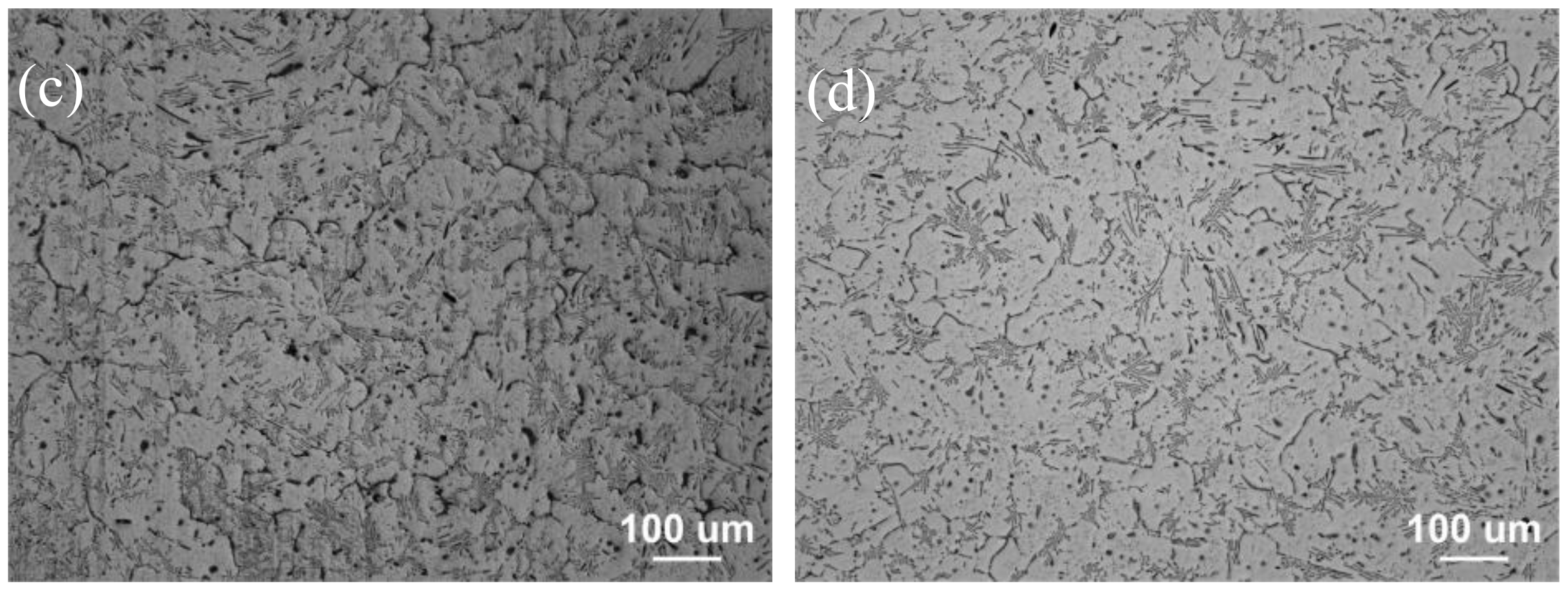
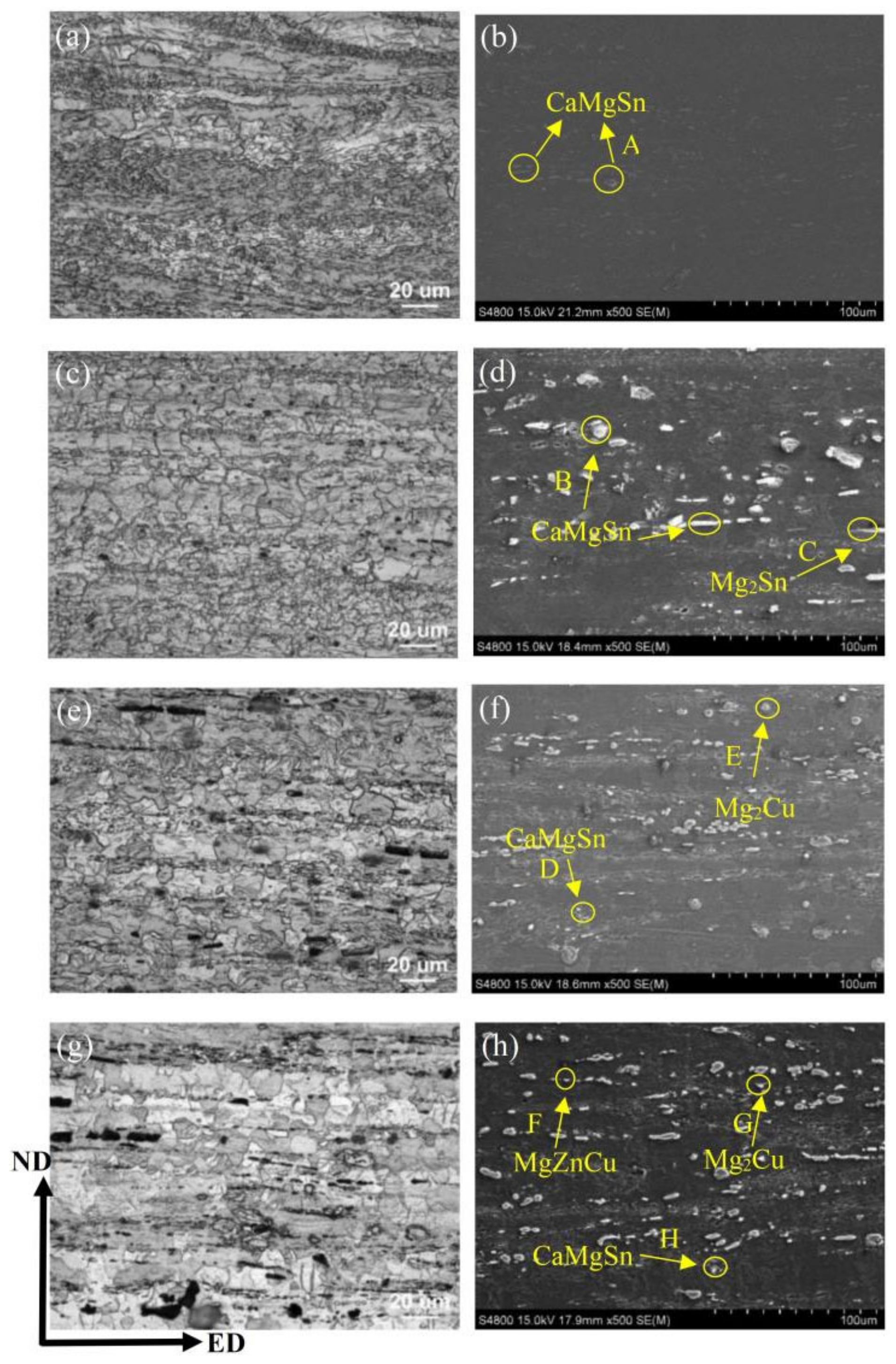
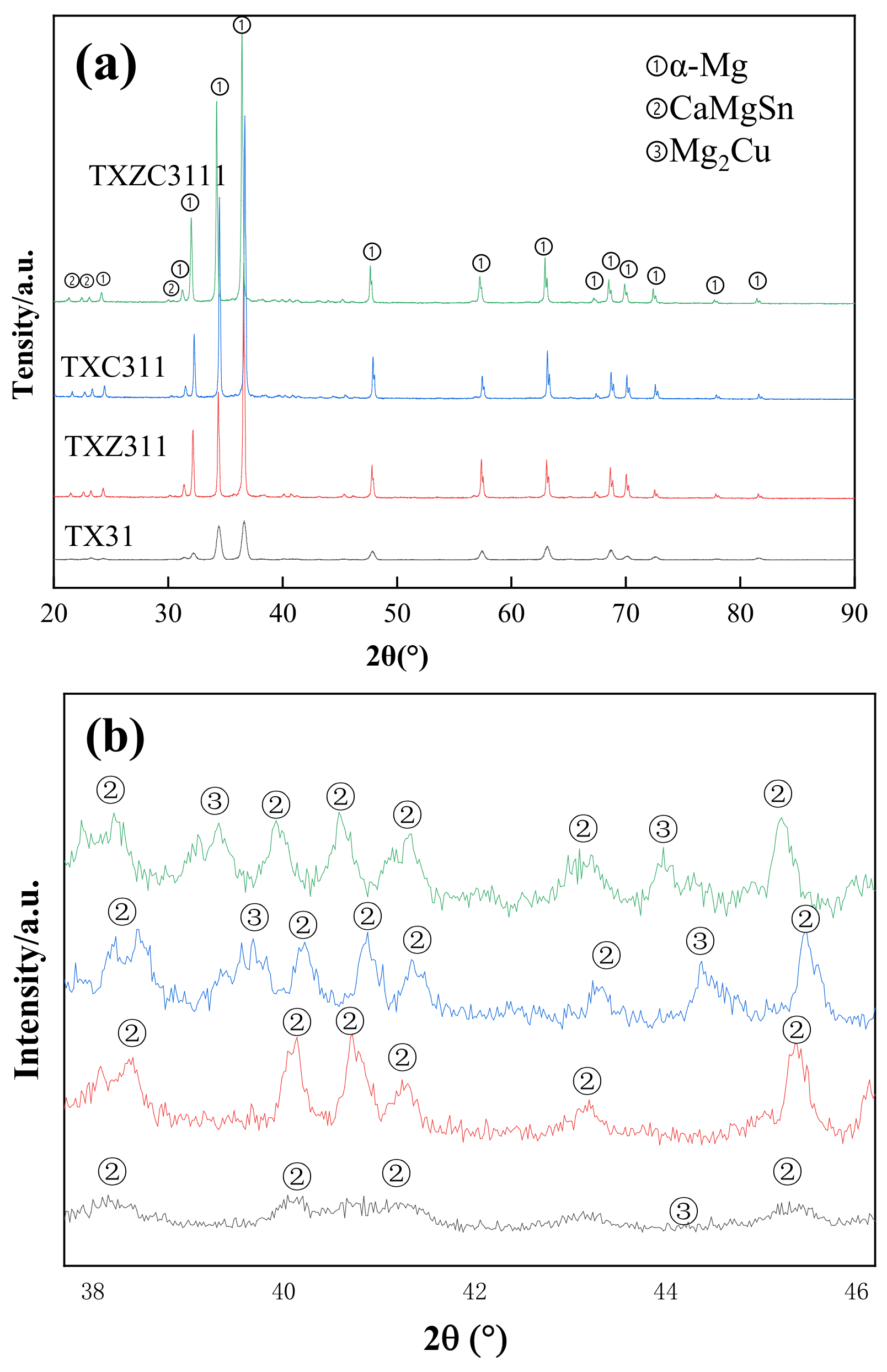
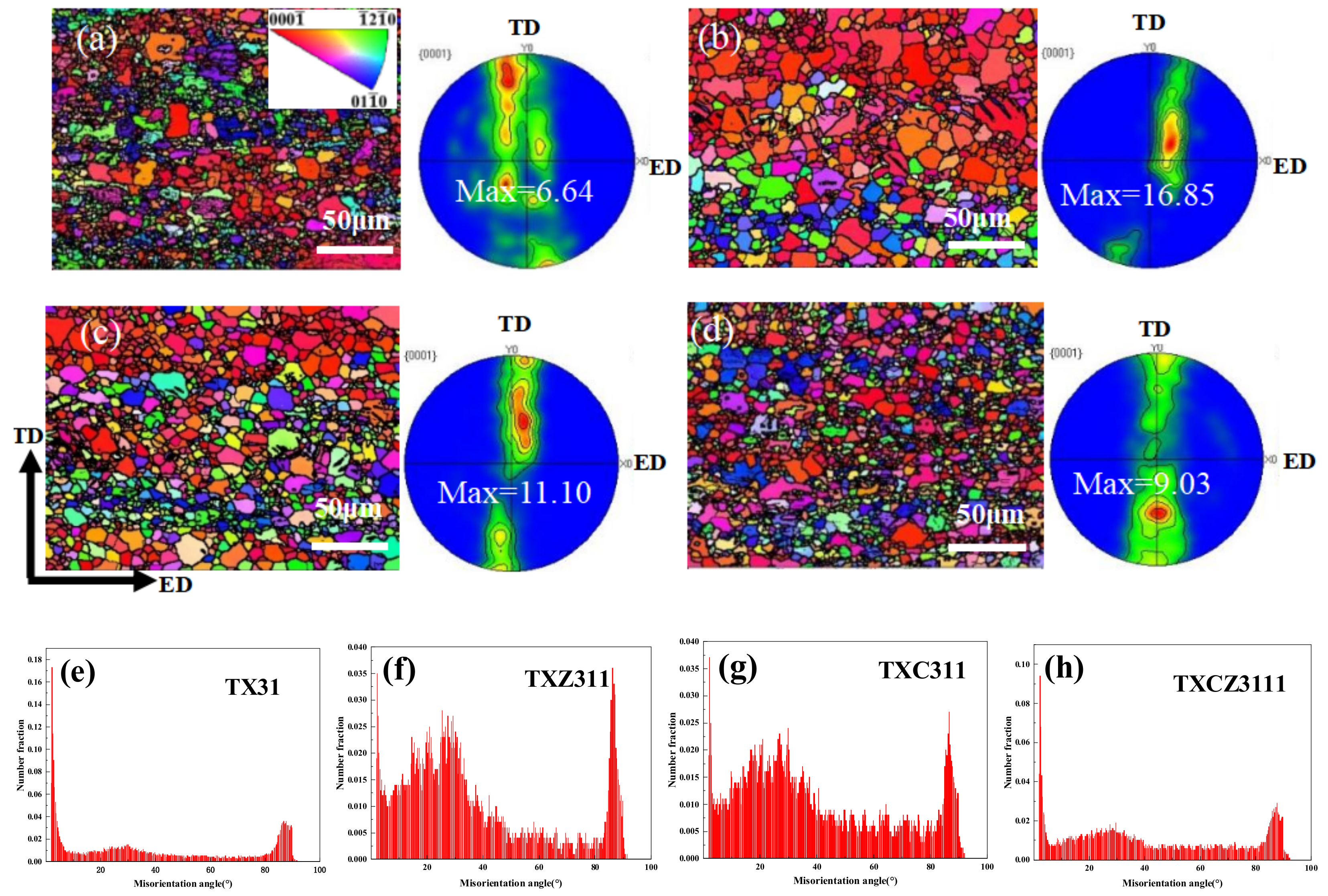
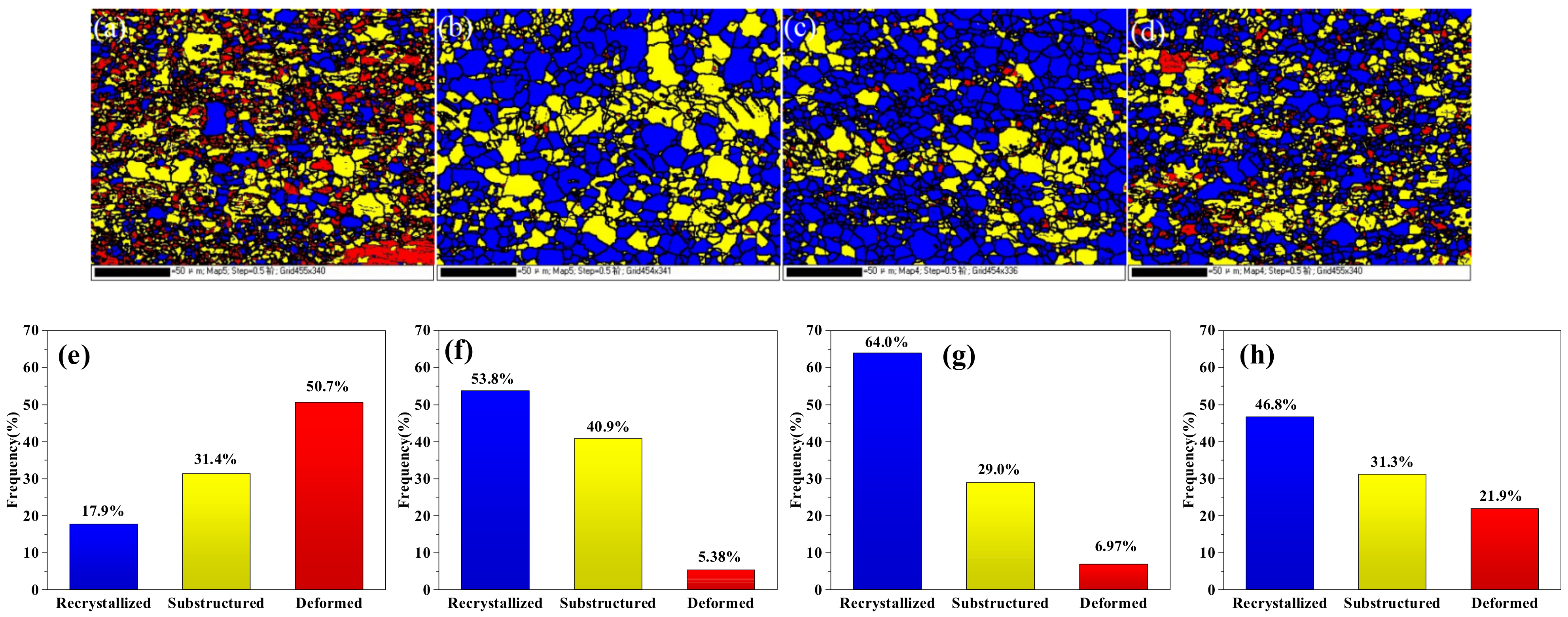
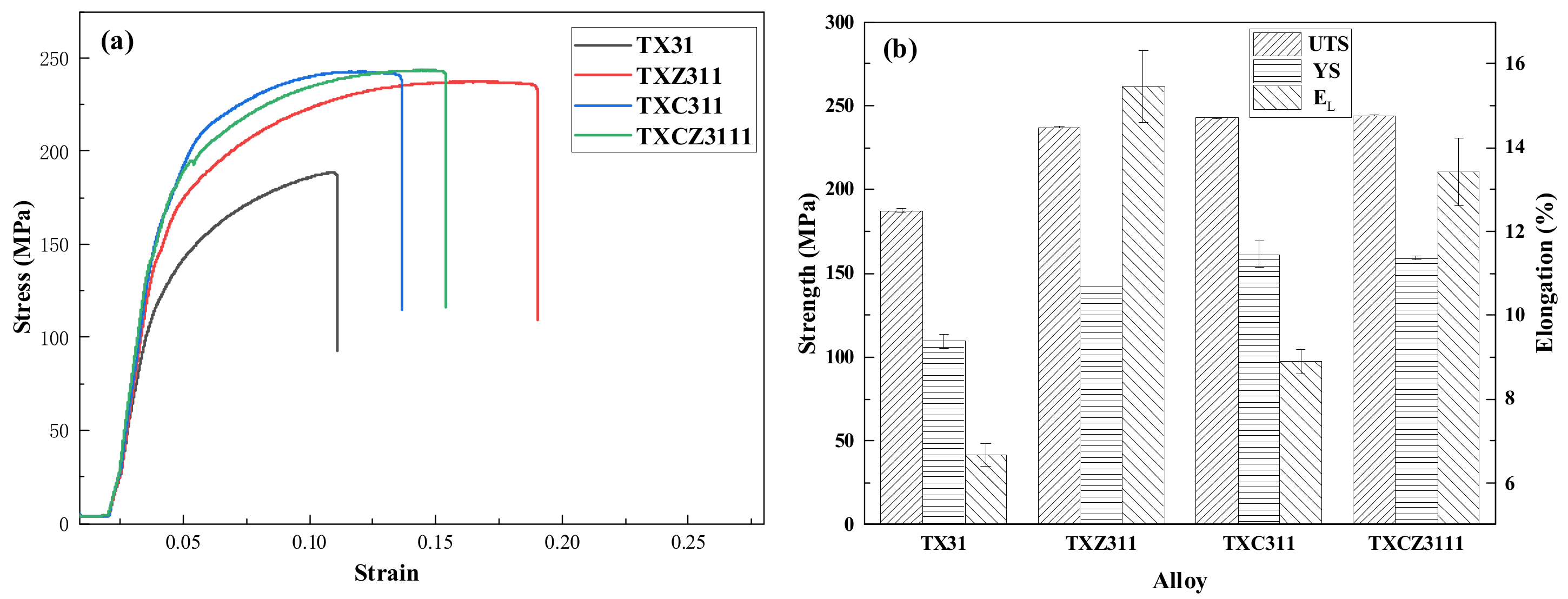
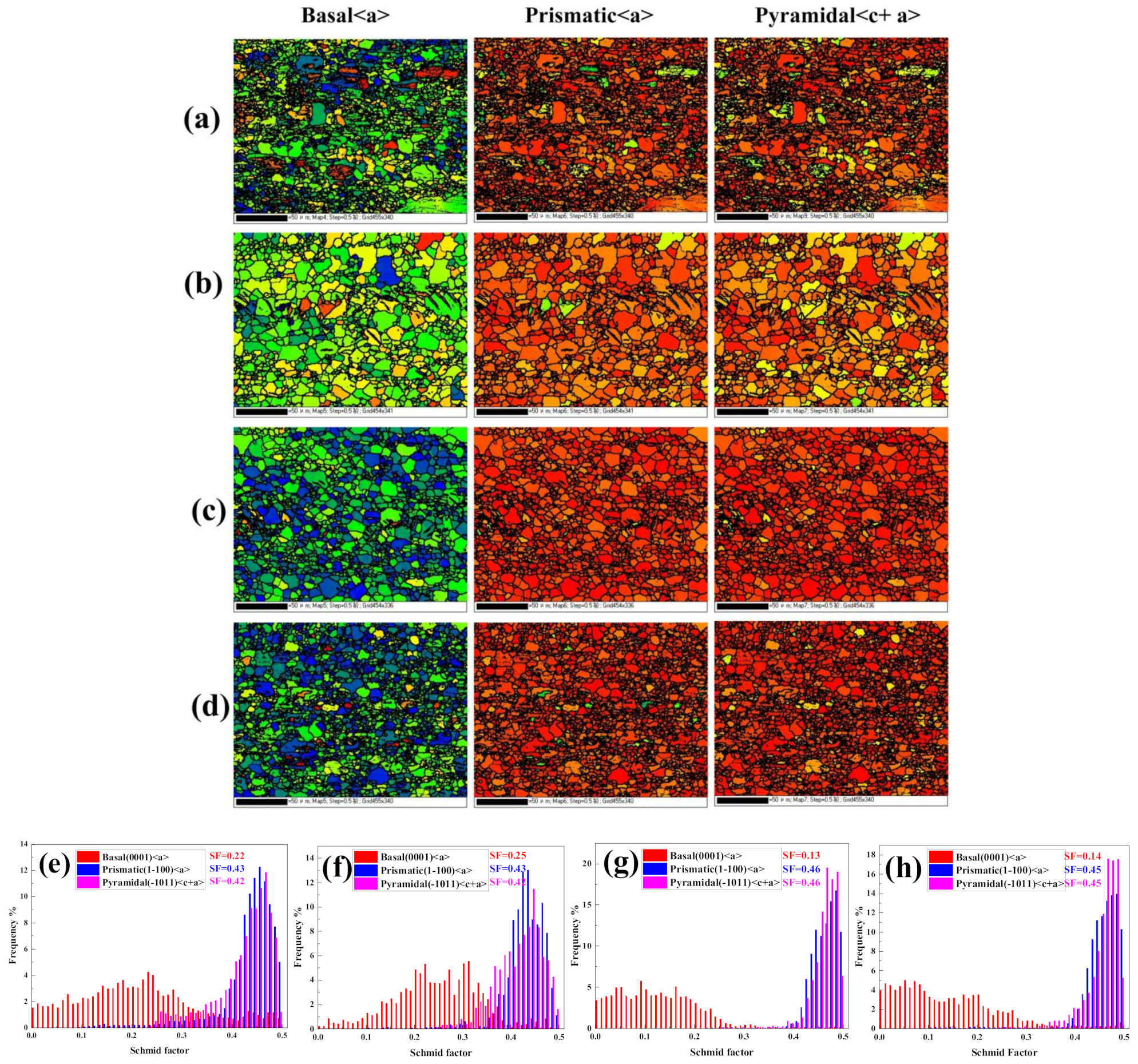
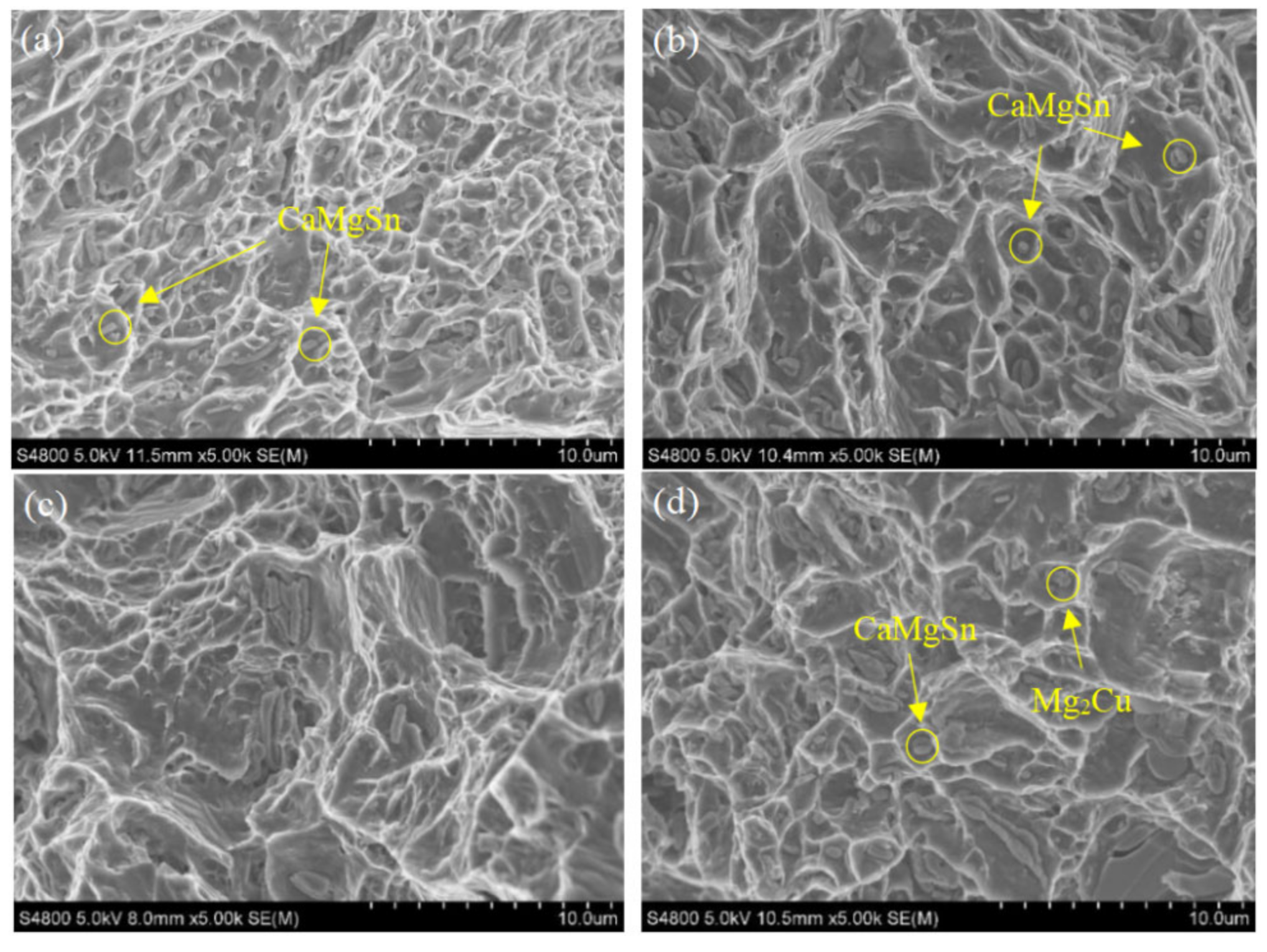
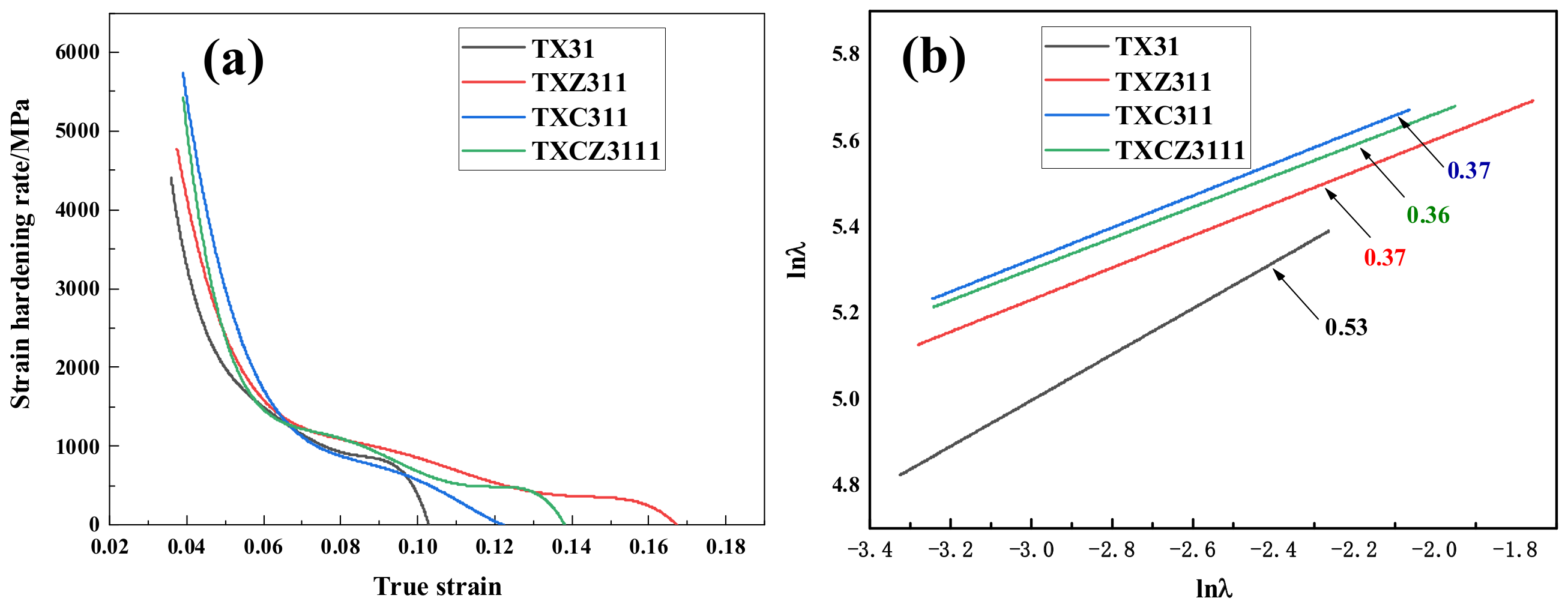
| Alloy | Measured Composition(wt.%) | ||||
|---|---|---|---|---|---|
| Mg | Sn | Ca | Zn | Cu | |
| Mg-3Sn-1Ca(TX31) | Bal. | 3.14 | 1.02 | 0 | 0 |
| Mg-3Sn-1Ca-1Zn(TXZ311) | Bal. | 3.12 | 1.02 | 1.09 | 0 |
| Mg-3Sn-1Ca-1Cu(TXC311) | Bal. | 3.22 | 1.04 | 0 | 1.07 |
| Mg-3Sn-1Ca-1Zn-1Cu(TXCZ3111) | Bal. | 3.18 | 1.04 | 1.07 | 1.04 |
| Alloy | Second Phase Size Distribution (μm) | ||||
|---|---|---|---|---|---|
| Area Fraction of Second Phase(%) | CaMgSn | Mg2Sn | Mg2Cu | MgZnCu | |
| TX31 | 7.5 ± 1.0% | 5~60 μm | - | - | - |
| TXZ311 | 11.0 ± 3.1% | 10~200 μm | 80~100 μm | - | - |
| TXC311 | 8.0 ± 1.4% | 58~110 μm | - | 30–70 μm | - |
| TXCZ3111 | 9.1 ± 1.8% | 8~100 μm | - | 20~40 μm | 20~30 μm |
| Point | Chemical Composition(at.%) | Phase Types | ||||
|---|---|---|---|---|---|---|
| Mg | Sn | Ca | Zn | Cu | ||
| A | 57.19 | 22.98 | 19.28 | - | - | MgSnCa |
| B | 66.50 | 17.89 | 14.58 | - | - | MgSnCa |
| C | 58.12 | 41.88 | - | - | - | Mg2Sn |
| D | 72.90 | 15.35 | 11.33 | - | - | MgSnCa |
| E | 72.87 | - | - | - | 27.13 | Mg2Cu |
| F | 65.36 | - | - | 16.92 | 17.72 | MgZnCu |
| G | 74.53 | - | - | - | 25.47 | Mg2Cu |
| H | 84.38 | 8.04 | 7.58 | - | - | MgSnCa |
Publisher’s Note: MDPI stays neutral with regard to jurisdictional claims in published maps and institutional affiliations. |
© 2022 by the authors. Licensee MDPI, Basel, Switzerland. This article is an open access article distributed under the terms and conditions of the Creative Commons Attribution (CC BY) license (https://creativecommons.org/licenses/by/4.0/).
Share and Cite
Jia, Z.; Yu, B.; Fu, L. Effect of Zn and Cu Addition on Mechanical Properties of As-Extruded Mg-3Sn-1Ca Alloy. Materials 2022, 15, 4438. https://doi.org/10.3390/ma15134438
Jia Z, Yu B, Fu L. Effect of Zn and Cu Addition on Mechanical Properties of As-Extruded Mg-3Sn-1Ca Alloy. Materials. 2022; 15(13):4438. https://doi.org/10.3390/ma15134438
Chicago/Turabian StyleJia, Zheng, Bing Yu, and Li Fu. 2022. "Effect of Zn and Cu Addition on Mechanical Properties of As-Extruded Mg-3Sn-1Ca Alloy" Materials 15, no. 13: 4438. https://doi.org/10.3390/ma15134438
APA StyleJia, Z., Yu, B., & Fu, L. (2022). Effect of Zn and Cu Addition on Mechanical Properties of As-Extruded Mg-3Sn-1Ca Alloy. Materials, 15(13), 4438. https://doi.org/10.3390/ma15134438





